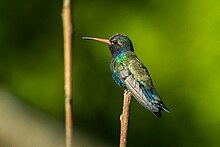Turquoise-crowned hummingbird
| Turquoise-crowned hummingbird | |
|---|---|

| |
| Scientific classification | |
| Domain: | Eukaryota |
| Kingdom: | Animalia |
| Phylum: | Chordata |
| Class: | Aves |
| Clade: | Strisores |
| Order: | Apodiformes |
| Family: | Trochilidae |
| Genus: | Cynanthus |
| Species: | C. doubledayi |
| Binomial name | |
| Cynanthus doubledayi (Bourcier, 1847) | |

| |
The turquoise-crowned hummingbird or Doubleday's hummingbird (Cynanthus doubledayi) is a species of hummingbird in the "emeralds", tribe Trochilini of subfamily Trochilinae. It is endemic to Mexico.[3][4]
Taxonomy and systematics
The International Ornithological Committee (IOC), the Clements taxonomy, and BirdLife International's Handbook of the Birds of the World consider the turquoise-crowned hummingbird to be a species.[3][5][4] The turquoise-crowned hummingbird is monotypic: no subspecies are recognised.[3]
Description
The Cornell Lab of Ornithology's Birds of the World does not describe the turquoise-crowned hummingbird separately from the broad-billed hummingbird.[6] The following is a Google translation of the original description's French:[7]
"Male adult: straight beak, dilated at its base, white, and black at its extremity; round head; green cap, very brilliante has azure reflections; neck, scapular, back, cover caudal fin glossy dark green; throat, front and sides of the neck, ėpi-gastre covered with shiny bright blue scaly feathers, abdomen less blue and green on the sides; downy anal region White; slightly curved grey-black wings; cordate [notched] tail with wide and rounded rectrices, black-blue, the 4 middle ones ashy at their ends; bare black legs."
The Birds of the World account of the broad-billed hummingbird includes that the male turquoise-crowned hummingbird weighs about 2.4 g (0.085 oz).[6]
Distribution and habitat
The turquoise-crowned hummingbird is found in the southern Mexican states of Guerrero, Oaxaca, and Chiapas.[5] It inhabits a variety of landscapes including arid thorn, tropical deciduous, gallery, and secondary forests. It occasionally occurs in pine-oak woodlands and grassy slopes. In elevation it generally ranges from sea level to 2,200 m (7,200 ft) but occurs as high as 3,000 m (9,800 ft).[6]
Behavior
Movement
The turquoise-crowned hummingbird is a year-round resident throughout its range.[6]
Food and feeding
The diet of the turquoise-crowned hummingbird is not separately described from that of the broad-billed hummingbird. In general, and like most hummingbirds, that species feeds on a wide variety of flowering plants and also small arthropods. The turquoise-crowned hummingbird is described as trap-lining for nectar in gallery forest.[6]
Breeding
The turquoise-crowned hummingbird appears to nest throughout the year; its peak season is unknown. Other information on its breeding phenology is not separated in the Birds of the World account.[6]
Vocalization
The turquoise-crowned hummingbird's vocalizations have not been separately described from those of the broad-billed hummingbird. That species' song, sung only by males, "[b]egins with short chip note, then a series of similar notes ranging in frequency from 2 to 13 kHz."[6]
Status
The IUCN has assessed the turquoise-crowned hummingbird as being of Least Concern. Though its population size is not known it is believed to be stable. No specific threats have been identified.[1] "Resident populations of broad-billed hummingbird in Mexico might...be impacted by habitat loss, but this has not been studied."[6]
References
- ^ a b BirdLife International (2021). "Turquoise-crowned Hummingbird Cynanthus doubledayi". IUCN Red List of Threatened Species. 2021: e.T22725775A168975499. doi:10.2305/IUCN.UK.2021-3.RLTS.T22725775A168975499.en. Retrieved 30 July 2022.
- ^ "Appendices | CITES". cites.org. Retrieved 2022-01-14.
- ^ a b c Gill, F.; Donsker, D.; Rasmussen, P., eds. (August 2022). "Hummingbirds". IOC World Bird List. v 12.2. Retrieved August 9, 2022.
- ^ a b HBW and BirdLife International (2021) Handbook of the Birds of the World and BirdLife International digital checklist of the birds of the world. Version 6. Available at: http://datazone.birdlife.org/userfiles/file/Species/Taxonomy/HBW-BirdLife_Checklist_v6_Dec21.zip retrieved August 7, 2022
- ^ a b Clements, J. F., T. S. Schulenberg, M. J. Iliff, S. M. Billerman, T. A. Fredericks, J. A. Gerbracht, D. Lepage, B. L. Sullivan, and C. L. Wood. 2021. The eBird/Clements checklist of Birds of the World: v2021. Downloaded from https://www.birds.cornell.edu/clementschecklist/download/ Retrieved August 25, 2021
- ^ a b c d e f g h Powers, D. R. and S. M. Wethington (2021). Turquoise-crowned Hummingbird (Cynanthus doubledayi), version 1.0. In Birds of the World (A. F. Poole and F. B. Gill, Editors). Cornell Lab of Ornithology, Ithaca, NY, USA. https://doi.org/10.2173/bow.brbhum2.01 retrieved July 30, 2022
- ^ Bourcier, Jules (1847). "Troch. Doubledayi". Proceedings of the Zoological Society of London. XV: 46. Retrieved July 30, 2022.


